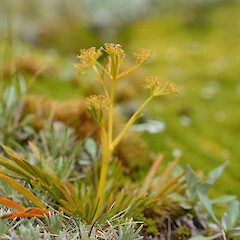Aciphylla similis
Synonyms
None
Family
Apiaceae
Flora category
Vascular – Native
Endemic taxon
Yes
Endemic genus
No
Endemic family
No
Structural class
Herbs - Dicotyledons other than Composites
NVS code
The National Vegetation Survey (NVS) Databank is a physical archive and electronic databank containing records of over 94,000 vegetation survey plots - including data from over 19,000 permanent plots. NVS maintains a standard set of species code abbreviations that correspond to standard scientific plant names from the Ngä Tipu o Aotearoa - New Zealand Plants database.
ACISIM
Chromosome number
2n = 22
Current conservation status
The conservation status of all known New Zealand vascular plant taxa at the rank of species and below were reassessed in 2017 using the New Zealand Threat Classification System (NZTCS) – more information about this can be found on the NZTCS website. This report includes a statistical summary and brief notes on changes since 2012 and replaces all previous NZTCS lists for vascular plants.
Please note, threat classifications are often suggested by authors when publications fall between NZTCS assessment periods – an interim threat classification status has not been assessed by the NZTCS panel.
- Conservation status of New Zealand indigenous vascular plants, 2017 . 2018. Peter J. de Lange, Jeremy R. Rolfe, John W. Barkla, Shannel P. Courtney, Paul D. Champion, Leon R. Perrie, Sarah M. Beadel, Kerry A. Ford, Ilse Breitwieser, Ines Schönberger, Rowan Hindmarsh-Walls, Peter B. Heenan and Kate Ladley. Department of Conservation. Source: NZTCS and licensed by DOC for reuse under the Creative Commons Attribution 4.0 International licence.
2017 | Not Threatened | Qualifiers: DP
Previous conservation statuses
2012 | Not Threatened
2009 | Not Threatened
2004 | Not Threatened
Distribution
Endemic. South Island, along the main divide from the Lewis Pass south to the Two Thumb Range. Also found in Westland on mountain ranges such as the Hohonu.
Habitat
Subalpine to alpine (900-1100 m a.s.l.) in open ground, usually in Rytidosperma dominated grassland or amongst open tall tussocks, often found in such vegetation types in ablation hollows or on stony well drained soils.
Detailed description
Rosettes clustered in groups of 10 or more, up to 200 mm diameter. Leaves up to 230 mm long, yellow-green, more or less rhombic on outline, coriaceous, with 6-7(or more) leaflet pairs, mainly in one plane; sheath 60 x 6-15 mm, sheath joint evident; stipules 40 x 1 mm, petiole 80 x 4 mm, concave or flat above, margins rounded, pulvinus up to 5 mm long, conspicuous; lowermost leaflet up to 65 x 3-3.5 mm, apex acute, spine 2 mm long, midrib obscure, marginrib 0.2 mm wide, veins scarcely raised. Inflorescences broad. Female inflorescence up to 400 mm long, stem 300 x 5.5 mm, yellow or brown, head 100 x 90 mm, profile somewhat obdeltate; compound umbels up to 14, arranged in 2-3 whorls, with the terminal umbel the largest ; lower bracts 55 mm long with a subtending sheath 23 x 6 mm, stipules and 2 pairs of leaflets; upper bracts smaller, undivided with stipules. Lower compound umbels up to 80 mm long, peduncles 60 x 1 mm, primary bracteoles simple, 10 x 0.5 mm; simple umbels 7 or less, peduncles 16 x 1 mm; secondary bracteoles simple, 6 x 0.5 mm, bearing 12 or less flowers per umbel, pedicels 3 x 0.2 mm. Sepals 0.6 mm; petals 1.2 x 0.6 mm, cream or pale yellow, not inflexed; staminodes 0.3 mm long. Male inflorescences 300 mm or less, stem 170 x 4 mm, yellow; head 130 x 90 mm, ovate, more or less terete; compound umbels about 10, 2-3 whorled, terminal umbel > than lower laterals; bracts similar to female inflorescences; lower compound umbels 90 mm or less, peduncles 70 x 2 mm; primary bracteoles 15 x 1.5 mm; 15 or less, undivided, peduncles 10 x 1 mm; secondary bracteoles 5 x 0.2 mm; umbels bearing 15 or less flowers; pedicels 3 x 0.1 mm or less. Sepals 0.6 mm; petals 1.5 x 1 mm or less, cream or pale yellow, not inflexed; stamens 2 mm long. Mericarps 4.2 x 1.6 mm, dull pale brown, lateral ribs 0.3 mm wide; style up to 1.3 mm long.
Similar taxa
Most readily confused with A. monroi Hook.f. which is mainly found further north and east of the main range of A. similis. Both species overlap north and east of the Lewis Pass where distinctions can sometimes be blurred (possibly due to hybridism). From A. monroi , A. similis differs by its larger leaves (up to 230 cf 180 mm) and inflorescences (up to 400 cf 300 mm long). A similis also has more and broader leaflets (6-7 pairs cf. 4-5) that are yellow-green rather than grey-green (sometimes tinged yellow), and which are flattened in one plane rather than leaves whcih are somewhat folded upwards.
Flowering
November - February
Flower colours
Cream, Yellow
Fruiting
December - April
Life cycle
Winged schizocarps are dispersed primarily by wind (Thorsen et al., 2009).
Propagation technique
Easily grown in pots in an alpine house and does well in most situations except in climates prone to high humidity. Requires a free draining soil and a sunny situation, flowers best following a cold winter.
Etymology
aciphylla: From the Latin acicula ‘needle’ and the Greek phyllum ‘leaf’, meaning needle-leaf.
similis: Similar to another species
Attribution
Fact Sheet prepared for NZPCN by P.J. de Lange 28 May 2006: Description adapted from Dawson (1979).
References and further reading
Dawson, J. W. 1979: Aciphylla montana Armstrong, A. lecomtei sp. nov., and related species. New Zealand Journal of Botany 17: 339-351.
Thorsen, M. J.; Dickinson, K. J. M.; Seddon, P. J. 2009. Seed dispersal systems in the New Zealand flora. Perspectives in Plant Ecology, Evolution and Systematics 11: 285-309
NZPCN Fact Sheet citation
Please cite as: de Lange, P.J. (Year at time of access): Aciphylla similis Fact Sheet (content continuously updated). New Zealand Plant Conservation Network. https://www.nzpcn.org.nz/flora/species/aciphylla-similis/ (Date website was queried)




